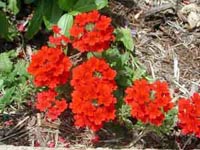Resource Library
Plant of the Week: Verbena
The University of Arkansas System Division of Agriculture does not promote, support or recommend plants featured in "Plant of the Week." Please consult your local Extension office for plants suitable for your region.
Plant of the Week
Verbena
Latin: Verbena x hybrida

Spring is upon us, and garden centers and nurseries are bursting with flats of colorful bedding plants. Though most consider them just flowers, they actually are a tangible symbol of the social and economic changes that swept the world as the Industrial Revolution took root and shaped the face of the world we live in today.
And it was the verbena that started it all.
The garden verbena (Verbena x hybrida) is familiar to most gardeners as a trailing annual that grows 6 inches high and may spread a couple feet in diameter, given enough room and good fortune. The flowers are produced in flattened spikes that are held above the foliage in 2-inch diameter clusters. Colors run the entire spectrum but the most outstanding are the reds and blues. The color intensity of verbenas is unmatched in the flower garden.
Gardening during much of the 18th century in Europe was strictly for the aristocracy. If commoners had gardens, they were of the utilitarian type, strictly food for the table. But as the Industrial Revolution gained momentum in the first quarter of the 19th century, this began to change and a middle class began to emerge.
By the 1851 census in Great Britain, for example, the urban population was larger than the rural population. This period is commonly referred to as the Victorian era, after Queen Victoria (1819-1901), who sat on the throne during much of the period.
The early 1800s were also the heyday of botanical exploration. One of these explorers, now almost forgotten, was James Tweedie (1775-1862). Tweedie was a Scottish gardener who had a respectable, but nondescript career until he succumbed to wanderlust at the age of 50. He boarded a ship bound for Buenos Aires, and with that faithful step accidentally changed the face of gardens around the world.
Tweedie made a number of important plant introductions from Argentina and Brazil, but it was the two verbenas and Petunia violacea - the predecessor of the modern petunia - that had the most lasting impact. His verbenas were quickly hybridized and, in short order, nurseries in Great Britain were offering over 50 named cultivars.
Tweedie was just one of many travelers sending plants back to Europe, so as they began to accumulate a new fashion in garden design was required to display them.
The solution of displaying all of these new plants appeared in the Victorian notion of carpet bedding. Carpet bedding was an abrupt change of course for garden design which had been comfortably entrenched in the "picturesque" movement which tried to simulate nature but improve upon it.
Victorian gardeners began to make beds in sunny places in their lawns for the new flowers. These beds, sprinkled about with little rhyme or reason, were usually square or round but sometimes took on the shape of stars, crescent moons, butterflies or even tadpoles. To fill all of these beds, took flowers, and lots of them. Thus was born the carpet bedding movement that remains with us today.
Verbenas are half-hardy perennials that occasionally will overwinter in the garden if planted in a location that is dry during the winter. They're also ideally suited for hanging baskets and container gardens. Mostly though, they're grown as annuals because verbenas don’t seem to care for our summertime heat. Hot weather brings on spider mites, the number one nemesis of this plant.
By: Gerald Klingaman, retired
Extension Horticulturist - Ornamentals
Extension News - March 26, 2004
The University of Arkansas System Division of Agriculture does not maintain lists of retail outlets where these plants can be purchased. Please check your local nursery or other retail outlets to ask about the availability of these plants for your growing area.